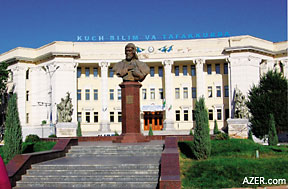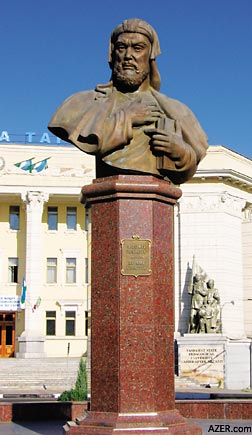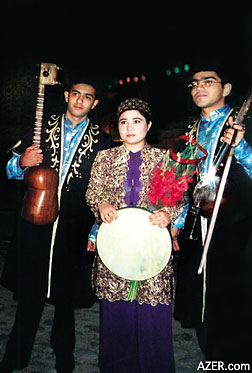|

Autumn 2005 (13.3)
Pages
70-72
Tashkent Festival
Aygun Baylar Wins Music Competition
by
Laurel Victoria Gray
Related Articles
Search at AZER.com
1. Nizami's
Seven Beauties: Ancient Wisdom for the New Millennium by
Laurel Victoria Gray. AI 13.1 (Spring 2005).
2. Alim Gasimov:
Master of Mugham by Betty Blair and Pirouz Khanlou. AI 9.1 (Spring
2001).
  Azerbaijan
and Uzbekistan share many cultural ties - not only historical
and linguistic. The dynamic nature of these connections became
an unexpected dimension of my most recent trip to Uzbekistan
this summer. Azerbaijan
and Uzbekistan share many cultural ties - not only historical
and linguistic. The dynamic nature of these connections became
an unexpected dimension of my most recent trip to Uzbekistan
this summer.
The focus of this, my eleventh, trip to Uzbekistan was the Fifth
Sharq Taronalari (Melodies of the East) [in Azeri, Sharq Taranalari]
International Music Festival, held from August 24-31, 2005, in
Samarkand.
Photo: Laurel Victoria Gray.
Deemed one of the world's most important festivals of Asian music,
the Sharq Taronalari Festival takes place every two years, attracting
the finest professional musicians from all over the world. The
competition, founded in 1997, is sponsored by UNESCO to bring
together people through the beauty of classical Oriental music.
This year more than 50 countries were represented.
From the first festival, Azerbaijani vocalists have shown a strong
presence. Mugham singer Simara Imanova won the Grand Prix in
1997. Alim Gasimov, another mugham performer, won it in 2001
and Zabita Nabizade took second place in 2003.
My ensemble, the Silk Road Dance Company, was the very first
American dance group ever to be invited to Sharq Taronalari -
a tremendous honor for us. Our program featured traditional Uzbek
and Tajik dances in our desire to express our great esteem for
the ancient Central Asian culture.
This year, the Festival honored the 15th century Uzbek poet and
statesman Alisher Navoi (1441-1501), who yearned for peace between
the peoples of the world. The Uzbek people openly acknowledge
Navoi's debt of inspiration to the 12th century Azerbaijani poet
Nizami (1141-1209). Like Nizami, Navoi also wrote poems, which
were collected and published as "Khamsa". Like Nizami,
he, too, had written a poem devoted to the Legend of Seven Beauties
(literally, Seven Planets).
Our Silk Road Dance Company had premiered our own productions
of Nizami's "Seven Beauties" in April 2005. Somehow
this made us feel so closely connected to these people despite
being nearly 8,000 miles from home.
Nizami
  And,
perhaps, Nizami really was watching over us because the Azerbaijani
connections began almost immediately after our arrival in Tashkent. And,
perhaps, Nizami really was watching over us because the Azerbaijani
connections began almost immediately after our arrival in Tashkent.
Left: Statue of 12th century Azerbaijani
poet, Nizami from Ganja, in front of Uzbekistan's Tashkent State
Pedagogical University named after Nizami.
I had scarcely set foot in the home of one of my mentors, People's
Artist of Uzbekistan Qizlarhon Dusmuhamedova, when the phone
rang. "They're calling from the museum," she explained.
"There's a gathering and they want you to attend."
  By
"the museum," Qizlarhon meant the Home Museum of Tamara
Petrossian (1905-1991), known as Tamara Khanim (Lady Tamara).
She was the legendary singer and dancer from Uzbekistan who once
risked her life to dance in public. She became their first performer
to travel to Europe to perform the art of Central Asia. Born
in the Ferghana Valley, Tamara Khanim eventually traveled the
world, building an impressive repertoire of songs and dances
of other nations, as well as collecting their traditional costumes,
which are now on display at the museum. By
"the museum," Qizlarhon meant the Home Museum of Tamara
Petrossian (1905-1991), known as Tamara Khanim (Lady Tamara).
She was the legendary singer and dancer from Uzbekistan who once
risked her life to dance in public. She became their first performer
to travel to Europe to perform the art of Central Asia. Born
in the Ferghana Valley, Tamara Khanim eventually traveled the
world, building an impressive repertoire of songs and dances
of other nations, as well as collecting their traditional costumes,
which are now on display at the museum.
Left: Name of Nizami is written first in
Uzbek and below in Azeri. Both countries - Uzbekistan and Azerbaijan
- have now rid themselves of the Cyrillic script since they gained
their independence from the Soviet Union and have adopted modified
Latin alphabet scripts which are different from each other.
Tamara Khanim's home has served as a cultural magnet for many
decades. When I first met her there in 1984, she told me that
I was her very first American guest. Leading artists were gathered
at her table then, and I later discovered that her home had continued
to be a hub of creative activity - even after her death.
Aygun Baylar
At the museum, we were greeted by old friends. One of them immediately
introduced me to a remarkable, bright-eyed young woman, dressed
in jeans and an embroidered hat. This was one of Azerbaijan's
most distinguished singers - Aygun Baylar. It turned out that
the party was in her honor. It was her birthday. Later she would
be performing at the festival.
  Soon Aygun and her
musicians, Toghrul Asadullayev on the kamancha and Rovshan Gurbanov
on tar (both traditional stringed instruments), took seats at
one end of the large room. Soon Aygun and her
musicians, Toghrul Asadullayev on the kamancha and Rovshan Gurbanov
on tar (both traditional stringed instruments), took seats at
one end of the large room.
Left: Vocalist Aygun Baylar shared First
Prize with Uzbek vocalist Nodira Pirmatova at Uzbekistan's Fifth
Sharq Taronalari (Melodies of the East) Competition in Samarkand
in August 2005. Musicians from more than 50 countries participated.
They had barely begun
the introductory melodic line when Aygun tilted her head back
and began to sway, giving forth an incredibly powerful voice.
We were all captivated. Qizlarhon and I exchanged glances.
This clearly was a prize-winning voice. The next day, our group
of Silk Road dancers arrived in Samarkand. We would travel together
with other festival participants in a bus caravan to Samarkand.
I told them about the events of the previous night. "Wait
until you hear Aygun," I told them. They did not have to
wait long.
Samarkand's Registan
The Festival was set against the architectural splendor of Samarkand's
Registan Square, a UNESCO World Heritage Site. The Square was
first built in the 15th century by King Ulugh-Bey of the Amir
Teymur Empire. It took two centuries to complete the 60-meter
wide, 100-meter deep, and 50-meter tall mosque and the surrounding
buildings. As one of the most representative Islamic master works
of architecture in the world, Registan Square was designated
as a World Heritage site in 2001.
In such a spectacular setting, the Festival seemed like something
out of an enchanted Eastern fairy tale. The opening concert boasted
hundreds of performers.
After the Opening Ceremony on the square, the festival participants
returned to Hotel Afrasiab for a gala banquet. Local Samarkand
musicians and dancers performed, but even in sunny Uzbekistan,
the proverbial ice had yet to be broken. Each delegation remained
at their assigned tables.
Then Aygun and her musicians came to the small stage adjacent
the dance floor. When she began to sing, everyone stopped talking.
Like a shaman of old, Aygun altered the energy of the hall. People
got out of their seats and ventured onto the dance floor. Soon
the banquet hall became a lively festival of nations, with music
as the common language shared by all.
Our concert on the Registan would be the high point of our trip.
We were scheduled for August 29 and would be performing on the
same night as Aygun - the final night of the festival when some
of the strongest performers were slated to perform.
Our group's presentation of traditional dances - Samarkand Ushori,
Saname, Keling Gular, and Guldasta - were warmly received and
we heard enthusiastic chants of "USA! USA!" from the
audience.
A bit later, someone whispered: "It's time for Aygun,"
and we watched as she walked onstage with Toghrul and Rovshan.
By this time, the other artists had heard her sing at informal
gatherings and were waiting to see how she would fare in the
competition.
Each country had only been allotted 20 minutes. A few countries,
Azerbaijan included, had sent two delegations, so that meant
they had to share the precious time on stage. Aygun would have
only 10 minutes in which to demonstrate her mastery of the traditional
modal music of mugham. We wondered if she could do it.
The musicians began to play and soon Aygun's voice - powerful
and confident, resounded throughout the legendary Registan Square.
George Curzon, a 19th century British traveler to the region,
had described the Registan as "the noblest public square
in the world." And there we were - sharing a night listening
to this enchanting music of remarkable artists from all over
the world, as diverse as the Seven Beauties by Nizami. For example,
there were performances of Uzbek-Tajik makom (mugham), Indian
raga, Turkish national songs, Kirghiz manas, Azerbaijani mughams,
Iranian dastgahi, Turkmen dastans, Japanese labor songs, Korean
and Chinese traditional melodies and songs, and Arabian maqams
(mugham).
  In
the East, one of the measures of artistic performance is its
ability to inspire, to enlighten, and to elevate human beings
beyond the mundane to a higher spiritual plain. In
the East, one of the measures of artistic performance is its
ability to inspire, to enlighten, and to elevate human beings
beyond the mundane to a higher spiritual plain.
Left: Members of the Silk Road Dance Company,
a dance troupe organized by Laurel Victoria Gray. This is the
first time an American dance group has ever been invited to the
Sharq Taronalari Festival in Samarkand, Uzbekistan.
Such is Aygun's gift. Our thoughts soared with her voice, making
us yearn to live together in peace. And if we could live together
like this for a week, perhaps we could do it for a month. And
if for a month; perhaps, for a year. And if for a year, then
why not longer?
All too soon her performance ended. Soon it would be time for
the jury to announce the Festival Awards. I didn't envy their
task. In 1997, I had served as a member of the jury on the very
first Sharq Taronalari Festival. I knew first hand the challenges
they faced. This year, some of the participants had given exceptionally
strong performances. In the end, the judges decided to share
the prizes, which seemed a wise decision.
Surprisingly, the Grand Prize of the festival was not awarded
this year. Instead, the prize money was distributed between artists
who tied for first, second and third places.
Third place went to musicians from South Korea, Bangladesh and
Israel. Second place went to artists from Kuwait, Italy and Mongolia.
Musicians from Afghanistan endeared themselves to all with their
songs about Samarkand and were awarded a special UNESCO Prize.
Our friends from the El Qamia Ensemble, an instrumental group
from the Cairo Opera House, earned a Special Award from the jury.
And then there was Aygun. Aygun Baylar took First Place along
with Uzbek vocalist Nodira Pirmatova. Both shared the highest
accolades of the festival, and both were awarded for "Best
Performance of a National Song."
Founder and Artistic Director
of the Silk Road Dance Company, Laurel Victoria Gray is the recipient
of the Kennedy Center 2003 Local Dance Commissioning Project
Award and the International Academy of Middle Eastern Dance (IAMED)
Awards for Best Choreographer (2003) and Best Ethnic Dancer (1999).
Her articles have appeared in academic and popular publications.
In 1984, she founded the Uzbek Dance and Culture Society (UZBEKDANCE.org).
In 1994 she established the annual Central Asian Dance Camp.
Gray teaches dances of the Islamic World as Adjunct Faculty at
George Mason University in Fairfax, Virginia, and George Washington
University, Washington, D.C. Visit: LAURELVICTORIAGRAY.com. Contact
Gray: Qyzylbosh@aol.com.
Back to Index AI 13.3 (Autumn
2005)
AI Home
| Search | Magazine
Choice
| Topics
| AI Store | Contact us
Other Web sites
created by Azerbaijan International
AZgallery.org | AZERI.org | HAJIBEYOV.com
|





